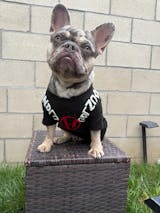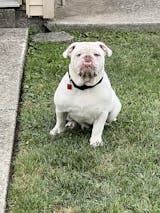Treating Your Dog's Blocked Tear Ducts
For dog owners of long-haired or wrinkly breeds such as English Bulldogs, Frenchies, and Pugs, blocked tear ducts can be a troublesome issue. Blocked tear ducts in dogs are common among these breeds and can cause excessive tearing, irritation, and infections if left untreated. In this blog post, we'll discuss the causes and symptoms of blocked tear ducts in dogs, as well as diagnosing and treating the condition.
By understanding the causes of blocked tear ducts in dogs, pet parents can help prevent the condition from occurring or worsening in their furry friends. With proper care and treatment, most cases of blocked tear ducts in dogs can be managed successfully. So let's dive into what you need to know about blocked tear ducts in dogs.

Causes of Blocked Tear Ducts in Dogs
The most common cause of blocked tear ducts in dogs is congenital malformation or obstruction. This occurs when the eye’s lacrimal duct, which carries tears from the eye to the nose, is either too thin or becomes obstructed for some reason. This can be seen more often in long-haired and wrinkly breeds such as English Bulldogs, Frenchies, and Pugs due to their facial anatomy. Other possible causes may include injuries near the eyes, tumors blocking the duct, or a bacterial infection within the tear duct itself.
Symptoms of Blocked Tear Ducts in Dogs
Excessive tearing and eye discharge are the main symptoms of blocked tear ducts in dogs. Other signs may include redness and swelling around the eyes, as well as a bad odor coming from the eyes due to bacterial infection. If left untreated, these symptoms can worsen over time and could lead to more serious complications such as ulcers or corneal damage.
Diagnosing Blocked Tear Ducts in Dogs
If you notice any of the above symptoms in your dog, it's important to take them to the vet right away for an examination. The vet will perform a physical exam and use specialized equipment such as an ophthalmoscope to detect any blockages. Further testing may be needed to confirm the diagnosis, such as an ultrasound or MRI.
Treating Blocked Tear Ducts in Dogs
If your vet diagnoses your dog with blocked tear ducts, they will recommend a course of treatment. Treatment options may include massaging the area around the eye to try and unblock the tear duct, antibiotics to treat any bacterial infections, and surgery if needed to remove any blockages or growths. In some cases, a stent may be inserted into the lacrimal duct to help keep it open and allow for proper drainage.
Preventing Blocked Tear Ducts in Dogs
The best way to prevent blocked tear ducts in dogs is by maintaining good hygiene around the eyes. This includes regularly wiping away any tears or discharge, as well as checking for foreign bodies that may be blocking the tear ducts. You can use a damp cloth to start the process, though we recommend using our Squishface Wrinkle Wipes to make sure the area is free of bacteria and any infectious agents. Do not use spraying water or shampoo but do be careful to keep it out of the dog’s eyes.
A topical paste works best for cleaning these areas. Use Wrinkle Paste for your short-haired or long-haired pups! Both of these pastes create a water-repellent barrier to keep moisture – and the potential for bacteria or fungal growth – at bay!
Owners of long-haired and wrinkle breeds should also make sure to keep their dogs' fur groomed and trimmed around the eyes to minimize the risk of blocked tear ducts.
The Bottom Line
Blocked tear ducts in dogs can cause excessive tearing, irritation, and infections if left untreated. While it is more common among certain breeds such as English Bulldogs, Frenchies, and Pugs due to their facial anatomy, any dog can develop this condition. By understanding the causes and symptoms of blocked tear ducts in dogs as well as proper diagnosing and treating techniques, pet parents can help their furry friends stay healthy and happy.
Be sure to follow us on TikTok, Instagram, Facebook, Pinterest, YouTube, and visit our blog weekly for more tips on caring for your wrinkly doggo, and the latest on all things Squishface!










